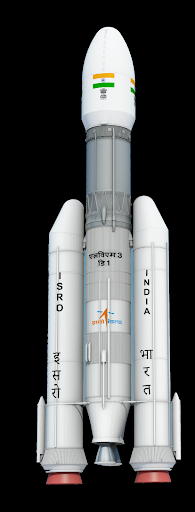Launch Vehicle Mark 3 (LVM3 or GSLV Mark 3)
Why in News:
- The Indian Space Research Organisation’s (ISRO) heaviest rocket Launch Vehicle Mark 3 (LVM3 or GSLV Mark 3) has successfully orbited 36 satellites of U.K.-based OneWeb.
- With this launch, LVM3 has made its entry into the global commercial launch service market.
Technical details of LVM3
- GSLV MkIII is configured as a three stage vehicle with two solid strap-on motors (S200), one liquid core stage (L110) and a high thrust cryogenic upper stage (C25).
- Payload to GTO: 4,000 kg: GSLV Mk III will be capable of placing the 4 tonne class satellites of the GSAT series into Geosynchronous Transfer Orbits.
- Payload to LEO (Low Earth Orbit) : 8,000 kg: The cryogenic stage of GSLV Mk III enables it to place heavy payloads into Low Earth Orbits of 600 km altitude.
- Cryogenic Upper Stage : powered by CE-20, India’s largest cryogenic engine, designed and developed by the Liquid Propulsion Systems Centre.
- Solid Rocket Boosters : GSLV Mk III uses two S200 solid rocket boosters to provide the huge amount of thrust required for lift off. The S200 was developed at Vikram Sarabhai Space Centre.
- Core Stage : The L110 liquid stage is powered by two Vikas engines designed and developed at the Liquid Propulsion Systems Centre.

About LVM3
- LVM3-M2 is the dedicated commercial satellite mission of NewSpace India Limited (NSIL), a Central Public Sector Enterprise (CPSE) under the Department of Space, Government of India.
- This mission is being undertaken as part of the commercial arrangement between NSIL and m/s Network Access Associates Limited (m/s OneWeb Ltd), a U.K. based company.
- OneWeb is a joint venture between India’s Bharti Enterprises and the U.K. government.
What OneWeb is aiming to achieve?
- OneWeb aims to activate global coverage in 2023, while its connectivity solutions already live in regions north of 50-degrees latitude.
- This partnership with NSIL and ISRO demonstrates OneWeb’s commitment to provide connectivity across the length and breadth of India by 2023.
- From Ladakh to Kanyakumari and Gujarat to Arunachal Pradesh, OneWeb will bring secured solutions not only to enterprises but also to towns, villages, municipalities and schools, including the hardest-to-reach areas across the country.
Why the name change?
- The reason behind changing the name of the vehicle from GSLV to LVM is that the rocket will not deploy the satellites in the geosynchronous orbit alone.
- The OneWeb satellites operate in Low Earth orbit (LEO) at an altitude of 1,200 kilometers.
- The geosynchronous orbit, on the other hand, is located 35,786 kilometers above Earth’s equator. It is a prograde, low inclination orbit about Earth having a period of 23 hours 56 minutes 4 seconds.
- A spacecraft in geosynchronous orbit appears to remain above Earth at a constant longitude, although it may seem to wander north and south.
- The cryogenic stage of the vehicle allows it to place heavy payloads into Low Earth Orbits of 600 km altitude, while it can also place four-tonne class satellites of the GSAT series into Geosynchronous Transfer Orbits.
References:
- https://www.thehindu.com/sci-tech/science/isros-dedicated-commercial-satellite-mission-lvm3-m2oneweb-india-1-lifts-off/article66046363.ece
- https://www.indiatoday.in/science/story/isro-oneweb-launch-gslv-mk-iii-lvm-3-rocket-2286187-2022-10-17
- https://www.isro.gov.in/GSLVmk3_CON.html
Subscribe
Login
0 Comments
